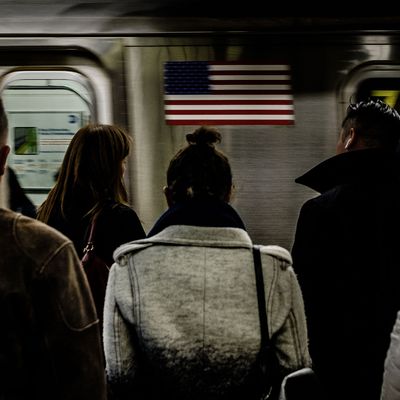
You don’t take the subway, right? is a question that I — like many New Yorkers who grew up outside the city and still travel home frequently — am intimately familiar with. It’s sort of a ridiculous question because, well, of course I take the subway; many of my waking hours are spent waiting for, taking, and griping about it. But it’s not an entirely ridiculous question, because, as safe as I know the New York City subway to be, there are a not-insignificant number of instances in my life where I opt not to take the subway, choosing instead between a number of ride-sharing options out of some contorted sense of self-protection.
I’m not alone. New York City’s women, on average, spend up to an additional $50 per month more on transportation than male residents, a new “pink tax” study from New York University’s Rudin Center for Transportation reports. Those added dollars were, according to participants, spent in the name of safety. (That figure, as noted by Wired, doubles if a woman is a primary caregiver.) Seventy-five percent of female participants said they’d experienced harassment or theft on public transportation. For men, that figure was 47 percent. Only 8 percent of male participants said they avoid public transportation at night, compared to 29 percent of women.
But what the study didn’t address — and what seems important to recognize — is that Uber or Lyft are often just slightly less bad options for women concerned about their personal safety.
In the world of ride-share horror stories, I’ve been relatively lucky. There have been drivers who’ve asked in vain for my number (which technically they already have); a driver going on and on about the attractiveness of myself and a co-rider, “both beautiful sisters wear glasses” (she’s not my sister, buddy); a driver who once called me 15 minutes after dropping me off to apologize for another rider, a male stranger with whom I’d pooled, and offered to come back to comfort me. I had no idea what he was talking about with regards to the other rider, but I did suddenly have the acute worry that this guy knew exactly where I lived and that I’d gone home alone. This certainly is not a characterization of all ride-share drivers, many of whom are polite and respectful and forgettable in the best way. But the ones that are not are the ones that stick with you, the ones who niggle at the back of your mind the next time you weigh your transit options. When I’m in the backseat of an Uber or a Lyft, I sometimes find myself instinctively sliding a ring I always wear on my right ring finger over to my left hand — a habit I picked up during some time abroad in college, a trick women are often taught in the gross hope that a man who is hitting on you will relent if you tell him you are already married.
I’ve also been lucky to the extent that, well, ride sharing is an option for me in the first place. “Because the researchers collected their survey responses on the web, they didn’t hit some key New York demographics,” Wired also notes. “A disproportionate number of their respondents had bachelor’s degrees or higher (93.4 percent compared to 34.5 percent citywide), and a disproportionate number lived on the Upper West Side, which is whiter and richer than the rest of the city.” A better version of this study would involve a much broader group of New Yorkers, but the lack of representation only puts the problem at hand into sharper relief. The dangers women face on public transportation are certainly not limited to women who are white or wealthy or both, but rather, likely worse for those who aren’t. There’s immense privilege in being able to pull out a phone and pay those extra dollars for a ride in the first place.
But that privilege isn’t a panacea. Women keep calling ride shares less for safety than for the illusion thereof. The illusion that getting into a car that is tracked by an app — an app that now offers a built-in option for dialing 911 — is a better, more controlled environment than hopping on a nearly empty subway car and crossing your fingers you don’t have to see some guy’s genitals as part of your commute, or worse. (If that sounds overly dramatic, find the nearest three women to you and ask them. They will likely tell you it’s not.) It’s an illusion that survives even though women have been assaulted by their ride-share drivers, raped (as recently as last week, according to a report from a woman in Boston) by their drivers, and kidnapped by their drivers. It is, without question, expensive to be a woman. But even if you can afford the burden of cost that comes with your gender, you still can’t buy safety.





























